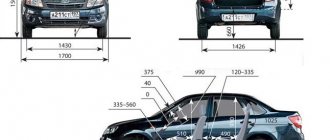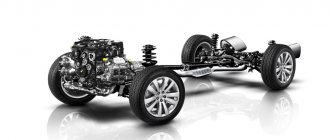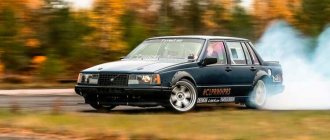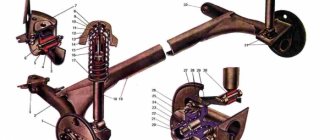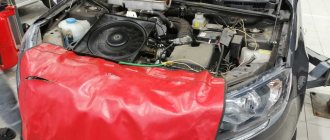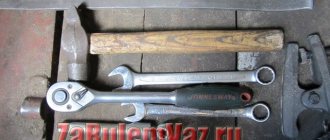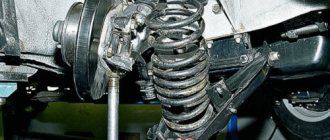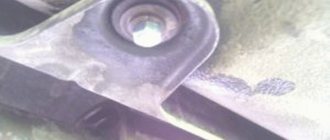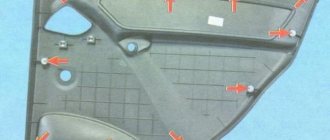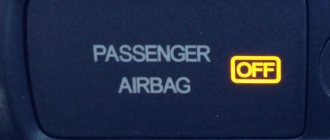Dear customers, in order to avoid errors when sending an oil shock absorber for the VAZ 2190 series COMFORT rear suspension, in the “Comment” line indicate the type of shock absorber (oil, gas-filled), your car model, year of manufacture.
A car shock absorber is one of those components that can only work properly in a certain position. Modern shock absorbers are rarely disassembled for repairs; as a rule, they are replaced assembled. That is why, before starting to operate a new unit, it must be prepared. If this is not done, the consequences can be very unpleasant.
Comfort series – hydraulic struts and shock absorbers, an optimal balance between comfort and controllability, suitable for those who like a quiet driving style in the city and on the highway.
One hundred thousand kilometers for a rack in VAZ front-wheel drive cars is a record time.
Considering the disgusting road surface that has shrouded the whole country, the suspension of eights, nines and their followers is getting pretty nuts.
As a result, everyone tries to protect themselves and the car as much as possible from possible sudden consequences of suspension failure. When stock racks reach the end of their life cycle, it's time to look for a replacement.
Suspension wear manifests itself in different ways and makes itself felt differently under different vehicle operating conditions.
It’s one thing - a hundred thousand on the smooth asphalt of the capital, but it’s a completely different story when your car constantly swallows dust on country roads or on the post-apocalyptic asphalt of the outback.
Also, one cannot discount the driving style, which, like handwriting, is individual for each driver.
Being clearly aware of your ability to predict the road situation, it is quite easy to predict the life of the suspension.
How many hits does the suspension get per week? How often do you look at the condition of the shock absorbers and how important is the delicate handling of the car in the conditions in which it drives most often? Having answered these questions, you can confidently say which struts are best installed on your car.
Comfort series - racks optimally combine the high technical level inherent in the design and the economic effect of operation. TM ASOMI stands are designed for a wide range of consumers.
- Failed shock absorbers can cause rapid wear and tear on the mechanical components of the car: suspension springs, steering gear, cardan, differential, rapid wear of tires, rapid failure of rubber suspension bushings, wheel bearings, suspension and CV joints.
- ADVANTAGES OF KIT RACKS series Comfort:
- — Optimal combination of characteristics for handling and comfort;
- — Guarantee effective traction of the car with the road;
- — Stable characteristics in the temperature range from -45°С to +45°С;
- — Reliable and silent operation;
- — 100% testing of struts and shock absorbers on the stand;
- — Collapsible, repairable design;
- — High resource.
- Bleeding oil shock absorbers before installation:
- 1. Install the shock absorber with the rod up, smoothly recess the rod, but leaving a distance of 20 mm between the working edge and the edge of the glass;
- 2. Let the shock absorber settle for five seconds;
- 3. Smoothly bring the rod to the maximum level;
4. Repeat the operation several times until the dips disappear and the operation of the device becomes uniform and smooth.
When accelerating, the car “squats” backward, loading the rear wheels and unloading the front wheels, thereby reducing their grip on the road. When braking, the opposite picture is observed. In both situations, the ideal would be a state in which the car would maintain its normal “horizontal” position.
The picture is approximately the same when maneuvering, but here the load shifts not along the axes, but along the sides of the car.
The main task of shock absorbers is to keep the wheel in constant contact with the road to prevent loss of control over the car. For this purpose, the wheel must go around the obstacle as softly and clearly as possible and just as clearly and quickly return to the road, providing the necessary grip.
Other articles of the product and its analogues in the catalogs: 2190-2915402, K190.2915.004-05.
- Lada Kalina 2, Lada Granta, Datsun / Datsun on-Do and mi-Do.
- Any breakdown is not the end of the world, but a completely solvable problem!
- How to independently replace the hydraulic shock absorbers of the rear suspension of the COMFORT series on a front-wheel drive car of the VAZ family.
- With the AvtoAzbuka online store, repair costs will be minimal.
Just COMPARE and BE SURE!!!
Don't forget to share the information you find with your friends and acquaintances, because they may also need it - just click one of the social networking buttons located above.
Rear suspension
+ Equipment and designations
+ Engine + Transmission + Brake system Steering, suspension and wheels
Steering column
Steering column Steering gear Steering drive Steering shaft Steering gear elements Steering gear housing Front suspension elements Front suspension arms Anti-roll bar Rear suspension Rear suspension arms with brakes Steering knuckles and hubs Wheels Wheels Rear wheel hubs + Electrical equipment + Body + Tools + Plugs + Tables normals + Wire harness fittings + Oil seals + Bearings
| 906-40 | ||||||||
| Item no. | Change notice no. | Release datefrom | Incl.w/h | Detail number | Option | Applicability | Col. | Name |
| 1 | + | 00001-0025745-11 | 2 | Nut M10x1.25 self-locking | ||||
| 2 | + | 21010-2905455-01 | 2 | Washer | ||||
| 3 | + | 21080-2915542-00 | 2 | Shock absorber bushing | ||||
| 4 | + | 21080-2915608-00 | 2 | Housing cover | ||||
| 5 | + | 11180-2912622-11 | 2 | Compression Progress Buffer | ||||
| 6 | + | 11180-2912622-10 | 2 | Compression Progress Buffer | ||||
| 7 | + | 21080-2915681-01 | 2 | Shock absorber housing | ||||
| 8 | + | 21100-2914046-00 | 1 | Lever bracket right | ||||
| 8 | + | 21100-2914047-00 | 1 | Left lever bracket | ||||
| 9 | + | 00001-0026297-01 | 6 | Washer 10 | ||||
| 10 | + | 00001-0005168-70 | 6 | Spring washer 10 | ||||
| 11 | + | 00001-0021647-11 | 6 | Nut M10x1.25 | ||||
| 12 | + | 00001-0061015-11 | 2 | Nut M12x1.25 | ||||
| 13 | + | 00001-0005170-70 | 2 | Spring washer 12 | ||||
| 14 | + | 21100-2914054-00 | ** | 2 | Lever joint | |||
| 14 | + | 21900-2914054-00 | * | 2 | Lever joint | |||
| 15 | + | 21080-2914040-00 | 2 | Lever bolt | ||||
| 16 | + | 21100-2915450-00 | 4 | Shock absorber cushion | ||||
| 17 | + | 21100-2912652-00 | 2 | Upper gasket | ||||
| 18 | + | 11180-2912712-10 | 2 | Rear suspension spring |
Causes of knocking in the front suspension
In total, there are four main reasons why noises and squeaks can annoy the Lada Kalina car owner, and three of them can be eliminated independently and everything can be returned to a safe state.
- The first reason why knocking occurs in the suspension is the poor quality of the road surface. A suspension that is in good working order can also produce some extraneous noise. If the noise disappears when you drive onto a good road, then everything is fine with your suspension, you can move on to the point below.
- If knocking and simultaneous vibration occur in the steering wheel, the reason may lie in a faulty steering rack. If you can tighten the steering rack yourself, then it is better to entrust its repair or replacement to professionals.
- The third reason is the front suspension strut spring that has lost its elasticity. Since the spring tone is significantly reduced, the suspension hits directly against the body. How to change the front struts, and along with it the spring, is described in detail in this article.
- And the last reason is cracked silent blocks, which are simply necessary to thoroughly dampen knocks and vibrations that occur while driving. Read below for information on how to properly replace these front suspension elements.
Repair and service of cars, engines and automatic transmissions
_____________________________________________________________________________
Rear suspension design of Lada Granta, Kalina
The rear suspension of the Lada Kalina/Granta VAZ-2190 is semi-independent, made on an “elastic” beam with trailing arms, coil springs and double-acting telescopic shock absorbers. The rear suspension beam consists of two trailing arms connected by a U-shaped cross member.
This cross-section provides the connector (cross member) with greater bending rigidity and less torsional rigidity. The connector allows the levers to move relative to each other within small limits. The levers are made of pipes of variable cross-section, which gives them the necessary rigidity.
Brackets for attaching the shock absorber, rear brake shield and wheel hub axle are welded to the rear end of each lever. At the front, the beam arms are bolted to removable brackets for the body side members.
The mobility of the levers is ensured by rubber-metal hinges (silent blocks) pressed into the front ends of the levers. The lower shock absorber eye is attached to the beam arm bracket. The shock absorber is attached to the body by a rod with a nut.
The elasticity of the upper and lower connections of the shock absorber is provided by a rod cushion and a rubber-metal bushing pressed into the eye. The shock absorber rod is covered with a corrugated casing that protects it from dirt and moisture.
In the event of suspension breakdowns, the stroke of the shock absorber rod is limited by a compression stroke buffer made of elastic plastic. The rear suspension spring of the Lada Granta/Kalina with its lower coil rests on the support cup (a stamped steel plate welded to the shock absorber body), and with its upper coil it rests against the body through a rubber gasket.
The rear wheel hub axle is installed on the flange of the beam arm bracket (it is secured with four bolts). The hub with a double-row roller bearing pressed into it is held on the axle by a special nut. The nut has an annular collar that securely locks the nut by jamming it into the groove of the axle. The hub bearing is a closed type and does not require adjustment or lubrication during vehicle operation.
Fig.31. Shock absorber spring for the rear suspension of Lada Kalina/Granta VAZ-2190
1 - spring; 2 — rubber gasket; 3 — casing cover; 4, 10 — shock absorber rod cushion; 5 — spacer sleeve; 6 — shock absorber casing; 7 - nut; 8 — spring washer; 9 — support washer; 11 — shock absorber rod; 12 — shock absorber body; 13 — lower spring support plate; 14 — nut of the shock absorber lower mounting bolt; 15 - eye; 16 — bolt of the lower shock absorber mounting; 17 - compression stroke buffer Checking the technical condition of the rear suspension of the Lada Granta/Kalina must be carried out in accordance with the periodic maintenance regulations. You can evaluate the technical condition of the rear suspension while the car is moving. When driving at low speed on an uneven road, the suspension should work without knocks, squeaks and other extraneous sounds. After driving over an obstacle, the car should not sway. It is better to check the performance of shock absorbers after a long trip, until the working fluid in the shock absorbers has cooled down.
Vigorously swing the rear part of the car body in a vertical direction. If, due to inertia, the body continues to oscillate (more than two: up and down) after it has stopped swaying, it means that one or both shock absorbers are faulty.
To identify a faulty shock absorber, we repeat the test, applying force first on one side of the car and then on the other. This check can only identify faulty shock absorbers. The effectiveness of vibration damping by shock absorbers can only be checked on a special stand.
We inspect the shock absorbers of the rear suspension of the Lada Granta/Kalina - fluid leakage from the shock absorbers is not allowed. Shock absorbers should be replaced as a pair, even if the second shock absorber on the rear suspension is working.
Visually check the condition of the rubber-metal hinges for fastening the shock absorbers and the arms of the rear axle beam. We replace hinges with one-sided bulging of rubber, tears and cracks. Check the tightness of the nuts securing the suspension parts and tighten them if necessary.
We inspect the suspension parts. Deformation and fatigue cracks in suspension parts are not allowed. We replace damaged parts.
- Replacing the shock absorber and spring of the rear suspension of Lada Kalina/Granta VAZ-2190
- Replacing the silent block of the Lada Granta/Kalina rear suspension beam
- Replacing the rear wheel bearing of a Lada Granta/Kalina
- _____________________________________________________________________________
- _____________________________________________________________________________
- _____________________________________________________________________________
- Lada Granta, Kalina
- _____________________________________________________________________________
- _____________________________________________________________________________
- VAZ-2110
— We remove the luggage compartment shelf. — Fold down the back seat. — Using a slotted screwdriver, remove the plug. — We install the device for disassembling the struts on the nut and shock absorber rod. Using two keys, hold the shock absorber rod from turning and unscrew its nut. — Use a magnet to remove the spring washer and the upper support washer from the shock absorber rod. — Remove the upper rod mounting pad from the shock absorber rod. — Using two 19 mm wrenches, unscrew the nut of the bolt securing the lower end of the shock absorber to the rear axle beam and remove the bolt. — Move the lower end of the shock absorber towards the rear of the Lada Granta/Kalina car and remove the shock absorber. — Remove the spring and its gasket from the shock absorber, and also, if necessary, remove the lower cushion and spacer from the shock absorber rod. — Springs of the same class (with the same color marks) should be installed in the rear suspension of the car. — Before installing the shock absorber, secure the rubber gasket to the spring with insulating tape or tape. — Install the spring on the shock absorber and fully extend the rod. We put a buffer, a protective casing with a cover, a spacer sleeve and a lower cushion (if they are not on the rod) onto the shock absorber rod. — When installing the Lada Kalina/Granta VAZ-2190 shock absorber, it is necessary to orient it so that the end of the lower coil of the spring faces the wheel. — We insert the shock absorber rod into the hole in the body cup, at the same time an assistant puts the top cushion and support washer on the rod and tightens the rod nut a few turns. — Raise the lever until the holes in the shock absorber and beam bracket align. Install the lower shock absorber mounting bolt and tighten its nut (without tightening). — If you don’t have an assistant, you can first fix the shock absorber to the rear suspension beam. — Then, placing a stop under the rear lever, smoothly lower the car on the jack, while making sure that the shock absorber rod enters the hole in the body, and after that, put on the upper cushion with the support washer and tighten the nut. — We install the removed wheel (if the work was done without an inspection hole) and lower the car onto the wheels. We press the rear of the car several times to self-install the suspension elements. — Tighten the shock absorber rod mounting nut to a torque of 50-61.7 Nm (5.1-6.3 kg/cm). — Tighten the nut of the shock absorber lower mounting bolt to a torque of 66.6-82.3 Nm (6.8-8.4 kg/cm). To replace the silent block, removing the beam from the vehicle is not required. We change the silent blocks one by one: first at one, then at the other beam lever. — Place the car on a reliable stand and remove the rear left wheel. — Disconnect the elastic lever of the pressure regulator from the earring. — We release the left parking brake cable from the two brackets securing the cable to the left arm of the rear suspension of the Lada Granta/Kalina. — Unscrew the nut of the bolt securing the lever to the body bracket, holding the bolt with a 19 mm spanner. — We take out the bolt. Pull the lever down (without pulling the brake hose) and install the puller cup on the outside and a special washer on the inside of the lever. — Rotating the nut of the puller bolt, press the silent block into the cup. — The silent block has a stop on one edge, and therefore it should only be pressed out towards the threshold of the car. — Apply a soap solution to the cylindrical surface of the new silent block. — Install the puller cup on the inside of the lever. — Rotating the nut of the puller bolt, press the new silent block into the lever until it stops. — We install the lever in the Lada Kalina/Granta VAZ-2190 body bracket and fix it with a bolt and nut without tightening it. — The lever fastening bolt is inserted into the body bracket from the side of the car threshold. — We insert the elastic lever of the pressure regulator into the earring and secure it with a stopper. — We fix the hand brake cable in the brackets. — We install the wheel and remove the car from the stands. — Press the rear of the car several times to self-install the suspension. — We finally tighten the nut of the lever mounting bolt to a torque of 66.6-82.3 Nm (6.8-8.4 kg/cm). — We replace the silent block of the second lever in the same way. — Loosen the rear wheel hub nut in the same way as described on the front wheel. — Place the car on a stand, remove the wheel and brake drum. — Unscrew the nut and remove the thrust washer of the hub nut. — Use a puller to press the hub from the axle along with the bearing. — If the hub bearing has collapsed and its inner ring remains on the axle, we press it with a two-jaw puller, installing its grips in special recesses. — We install the rear wheel hub of the Lada Kalina/Granta VAZ-2190 in a vice. — Use a puller to compress and remove the bearing retaining ring. — Use a cup puller to press the bearing out of the hub. — Using the outer ring of the old bearing as a mandrel, we press the new bearing into the hub with a puller. — Use a puller to install the bearing retaining ring. — Install the hub on the axle. — Install the thrust washer and tighten the rear wheel hub nut of the Lada Granta/Kalina. — By tightening the nut, we press the bearing onto the hub axle. — Install the brake drum and wheel. — We lower the car onto its wheels. — Tighten the hub nut to a torque of 186.3-225.6 Nm (19-23 kg/cm) and jam the edge of the nut into the groove of the hub axis. — Install the hub cap.
Lada Granta. Technical part. About suspension and handling
Yandex pictures
Lada Granta went on sale at the end of 2011 based on the Lada Kalina and gradually ousted its predecessor from the market. Eight whole years have passed since the car was released; Granta has been changed and improved. But in the minds of many, it is still the same Kalina, with the same set of problems and sores; few people notice any changes. Apparently, having once encountered a Lada Granta of the first releases, car enthusiasts, having heard the word Granta, begin to remember that distant Granta, released a certain number of years ago, and armchair experts rewrite the stories of past years with reference to the present time and the restyled Granta. At the same time, they actively savor the differences between the first and second Renault Logan, Stepway, Duster, third and fourth generation Kia Rio, Solaris and others. What does it all have in common? That's right, one platform. Granta and Kalina are on the same platform, the listed Renault cars are also assembled on the same platform, Rio, Solaris are twin brothers. Meanwhile, no one sees the difference between the Granta of the first years and the restyling. But there is a difference, including in the suspension.
Front suspension. Yandex pictures.
The front suspension of the Lada Granta, as in many budget cars, is independent, with telescopic shock absorbers, coiled conical springs, lower wishbones with braces and anti-roll bars. What modifications have been made to the front suspension?
- the presence of a spring with an oversized coil diameter;
- gas-filled shock absorbers;
- reinforced longitudinal brace structures;
- increase in the diameter of the transverse stabilizer bar by 2 mm.
One of the solutions recognized to improve directional stability at high speeds (from 150 km/h) was to increase the steering angle of the wheels. The front suspension caster has been increased to 2°45′.
Because of this, the required force that should be applied to the steering wheel during a turn slightly increased, but this problem was solved by integrating an amplifier into the unit, which has an increased compensating effect and the use of a steering rack with a short stroke.
Thus, not only stability has improved, but also handling has improved, the number of steering wheel rotations has decreased, and the steering wheel has become more informative and sensitive. It should be noted that for the “Standard” configuration, the caster settings remained the same 1°40′.
Rear suspension. Yandex pictures.
The rear suspension is a good old beam with trailing arms, coil springs and telescopic shock absorbers. The beam is simple and reliable; no special changes were required.
We installed reinforced springs and gas-oil shock absorbers. The rear suspension of the Grant received a negative camber angle, minus 1°.
This was done, again, in order to improve the driving characteristics, as well as the stability of the car on the road.
The suspension of the Lada Granta is quite reliable and does not cause any problems. Periodic inspections and diagnostics will allow it to serve for a long time without problems. The most vulnerable parts of the front suspension are the ball joints. The rear suspension is practically indestructible.
As for handling, based on personal experience, I can say that the handling of the Lada Granta is excellent and the car does not lose stability and steering wheel even at 180 km/h. To confirm your words, read my article with a photo report where my Granta goes 180 km/h. LINK. All the best and good luck!
Design
Description of colors of Lada Granta Liftback
Before you understand the suspension structure, you need to divide it into front and rear. They are slightly different from each other, so we will look at them separately.
The front suspension has an independent structure consisting of two telescopic-hydraulic struts with shock-absorbing action. Each strut has a shock absorber spring.
front suspension Lada Granta
If any of the wheels gets into a hole, the second wheel located on the same axle will remain in an independent position. In order for both racks to be located on the same straight line when driving on a flat road, a special device is installed between them - a stabilizer.
The steering knuckle is attached to the outer edge of the rack. On it, in turn, there is an adjusting screw responsible for the camber angle of the front wheels.
Instead of the old fastening, in the form of a tightly inserted bearing, on all Lada Granta cars, regardless of body type: sedan or liftback, a steel bushing was installed, which was vulcanized to the rubber support. It is thanks to this difference that such a suspension did not emit extraneous noise, and also did not have any play.
On the new suspension of the Lada Grant, in the sedan and liftback body, the bearing was installed in only one place - between the spring and the body support. Thus, the entire weight of the machine was concentrated on him, and kept him in a constant compressed position. This means that there was also no backlash, and along with it, extraneous noise.
The rear suspension of Grants, sedan and liftback, is also the same. It is very similar in design to previous models, starting with the VAZ 2108 and ending with Kalina and Priora. Essentially, the principle of operation is the same as that of the front suspension, with the difference that instead of a stabilizer, a semi-rigid beam is installed. That is why it cannot be called independent. The fastenings are located in the same way as in the front. So, the front suspension does not have any special differences from the rear, but still, there is a difference between them.
Upgraded rear suspension
